Plasterboard ceilings in the bedroom: varieties and designs
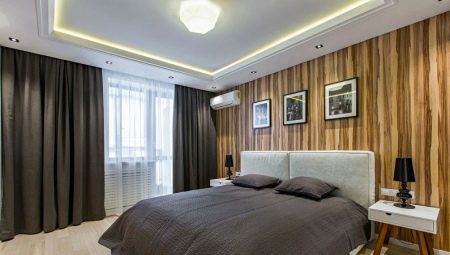
The design of the bedroom ceiling plays an important role in shaping the complete interior design. I want an impeccably smooth, reliable and durable coating, but not very expensive. All the indicated parameters are best matched by drywall - a well-known finishing material in the form of sheets of cardboard filled with a layer of gypsum. It is surprisingly practical and very easy to process, making it possible to quickly implement any novelty in design.

Advantages and disadvantages
The use of drywall for decorating ceiling coverings in residential premises is determined both by the characteristics of the building material itself, and by the possibilities that it provides for the implementation of extraordinary design developments. GCR is very plastic, which allows you to create complex multi-tiered structures and figures of the most different shapes:
- circles and ovals;
- squares and rectangles;
- non-standard, for example, in the form of a heart.
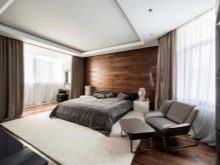
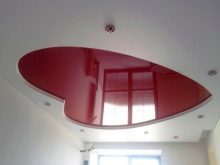
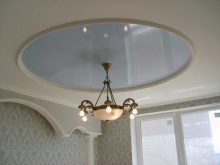
The advantages of using gypsum plasterboard sheets for lining the ceiling in a bedroom are in the following factors:
- environmental safety of building materials, as it is made of gypsum of natural origin;
- it is cut without much effort, therefore it is optimal for the implementation of complex design structures;
- evens out defects, creates a completely smooth plane;
- uncomplicated in installation work;
- durable, service life up to 60 years;
- maintainable, easy to clean from dust;
- greatly facilitates the laying of internal communication systems, for example, such as electrical wiring and ventilation;
- available at cost.
The main advantage of plasterboard ceilings is that they are combined with other materials, for example, wallpaper, PVC film for stretch ceilings, and decoration components.
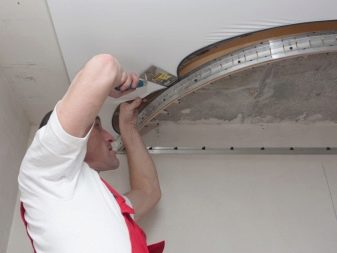

These benefits are so excellent that they override individual imperfections in the material, such as:
- the manufacture of ceilings from gypsum plasterboard in the bedroom reduces the height of the room by 12-15 centimeters, since it is mounted on suspensions, therefore, such a technique should not be used in small apartments;
- even moisture-resistant drywall is afraid of dampness;
- easily covered with cracks, in this regard, in houses made of wood, the installation of the ceiling can be carried out exclusively after the house has shrunk.
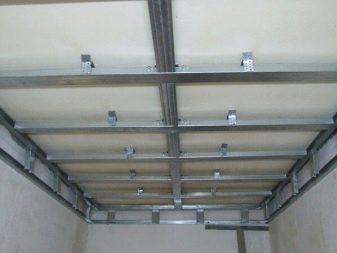
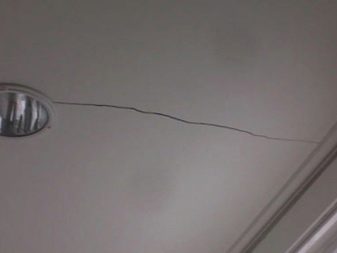
Views
Drywall is a pliable, easy-to-install material that can accept any configuration in the hands of a specialist and transform into multi-level structures, forming unusual ceiling compositions. By design, based on the complexity and combination of shapes, plasterboard-based ceilings are divided into 3 types.
Sibling
The sibling structure is the easiest to implement. Such drywall constructions look stylish, elegant and laconic.
I must say that such a design cannot provide very great opportunities for the flight of thoughts... You cannot make intricate configurations by means of single-level structures. Nevertheless, due to their own laconicism, they can perfectly fit the concept of a minimalist style in the interior of a bedroom.
Their refined style, specific charm, lack of useless decoration are perfect for rooms that serve for relaxation and sleep. And especially if the rooms do not differ in a significant ceiling height.
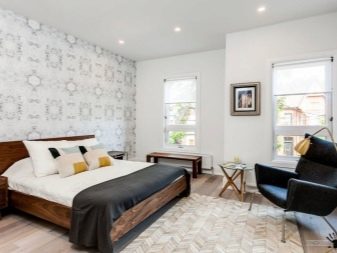
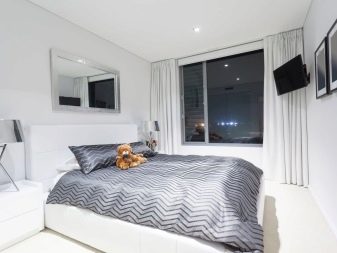
Tiered
Multi-stage plasterboard structures are chosen for sleeping quarters with high ceilings. In terms of the number of steps, 2- and 3-level are especially common.
Two-tier
Double structures have the ability to create the impression of a large space. Through them, you can implement the most complex ideas. The concave design is currently the most popular shape. Its competent installation adds a few centimeters in height to the room.
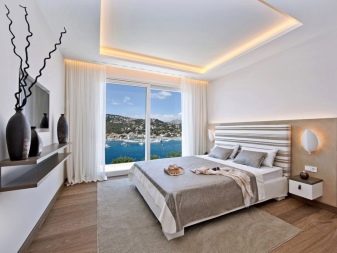
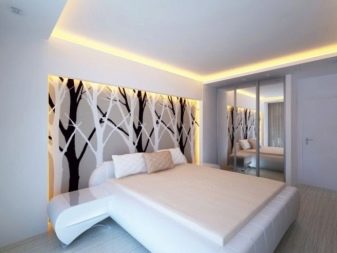
Such plasterboard ceiling structures are endowed with the main positive point - they give the master tremendous opportunities in terms of ceiling design. Stunning results can be achieved by organizing skilful interweaving of colors, configurations, materials and lighting elements.
Among other things, a two-level ceiling makes it possible to successfully zone the space of a bedroom.
For example, effectively highlight the bed area. And if you beat the options for the structure according to its configuration, you can achieve both a visual increase and a decrease in the room.
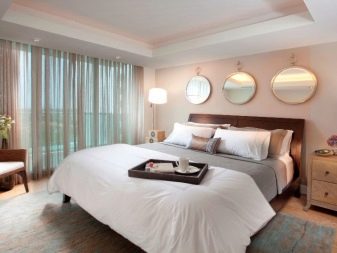
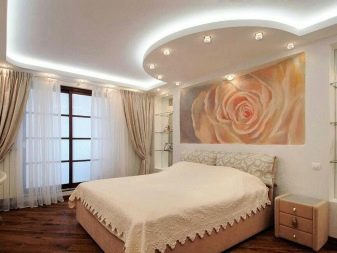
Three-tier
Such ceilings are a geometric structure that is not easy to implement and can be used for large rooms. They make it possible to advantageously zone spacious bedrooms, free from a feeling of vacuum.
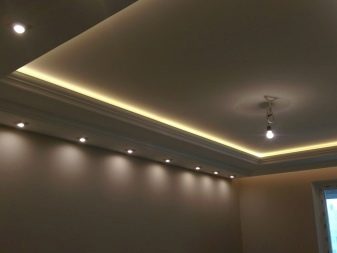

Combined
A huge selection of cladding materials makes it possible to practice several types of ceiling finishes. As an example, we can take the traditional combination of plasterboard framing and stretch fabric in the center, which is traditional today.
No less important is the use of mirrors, stained-glass windows, photowall-paper, Venetian or other decorative plaster in combination with plasterboard construction in the construction of combined ceilings.
And also plasterboard ceilings look elegant with wood, but only if it is present in other elements of the interior decoration.
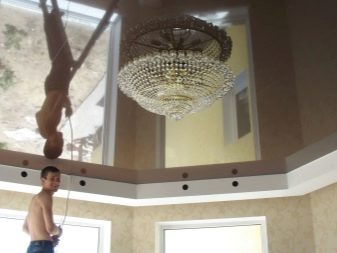
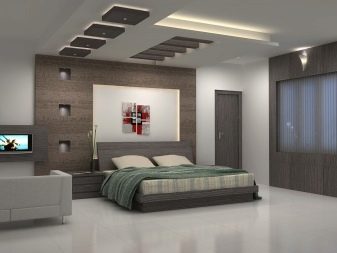
Design options
When creating a bedroom design, one must take into account that the suspended ceiling should become part of the entire interior design and interact in concert with the rest of the elements.
Therefore, thinking over the design, you need to pay attention to all the subtleties, and this:
- general view of the hinged structure, the number of levels, their location and configuration;
- the planned topcoat for the ceiling, taking into account the location of the hinged components, taking into account the combination of matching materials for decoration;
- color palette in terms of overall style;
- lighting and lighting, general concept and arrangement of lighting fixtures.
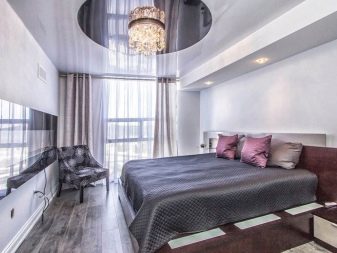
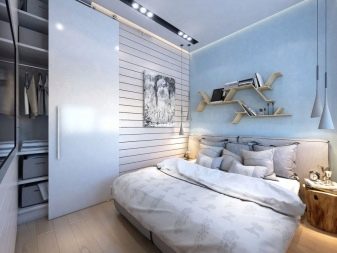
The decoration of the bedroom should ensure harmony in the soul and peace, therefore, when constructing a ceiling in a bedroom, you must also follow some general rules:
- a warm color palette not only has a pacifying effect, but also visually enlarges the room;
- to form an additional volume in a small room, a white ceiling must be used;
- dark colors will be appropriate for the design of a room with high ceilings;
- the use of smooth lines in the formation of the levels will give the bedroom a cozy atmosphere.
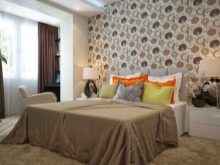
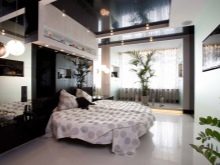
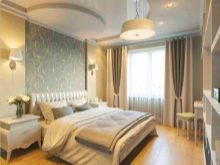
However, the variety of trends in modern design allows the use of different color compositions for decorating a bedroom, including rich colors, and the personal wishes of the owner of the room will, of course, be decisive. It is clear that there are no rigid frameworks, and everyone has the opportunity to choose their own option. However, certain specifics of the style must be taken into account.
So, if the bedroom is made in the Art Deco style, then a black GKL construction with silver design components will be absolutely normal.
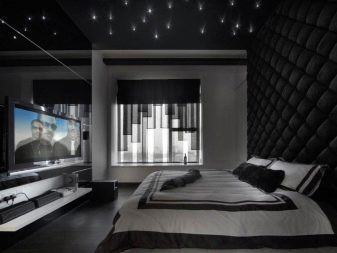
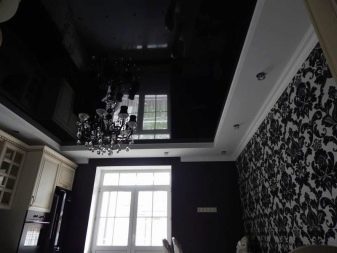
It is advisable not to use red in the decoration of the bedroom in a pure form. You can replace it with burgundy or wine red, which are optimal for decorating premises in the Baroque style.

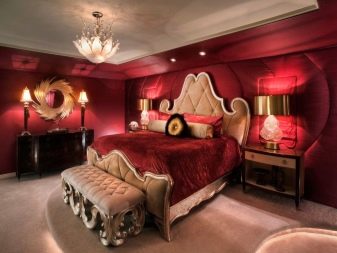
The choice of the size and configuration of ceiling niches and figures is also determined by the style trend. For example, curly ceilings of the correct geometric shape with rounded corners and stucco moldings will be an excellent solution for a classic style.
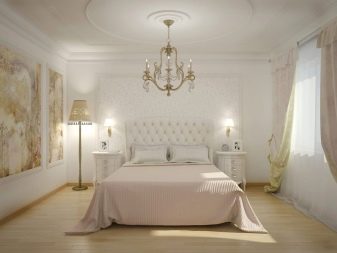
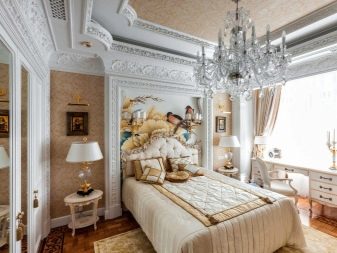
In a rocaille or baroque bedroom it is better to use a multi-stage design with backlighting and repeating decoration elementsplaced according to the symmetry rules.

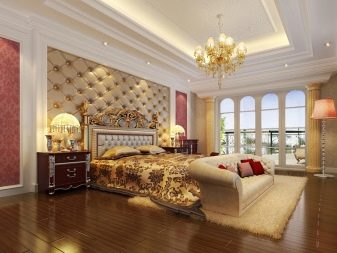
The modern bedroom is perfectly combined with asymmetric designs of various colors and shades, while constructivism in design involves the use of precise geometric shapes with the indispensable zoning of the area by means of a competent device of a multi-level ceiling.
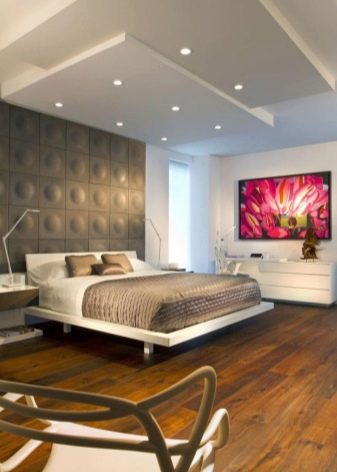
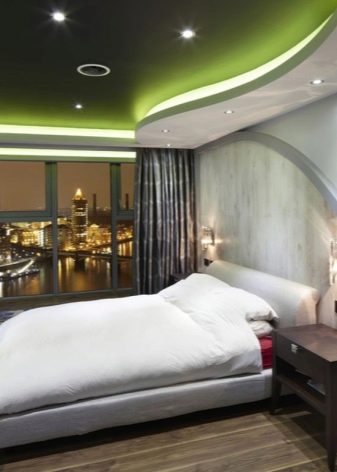
Sleeping rooms with a modern twist in high-tech style are perfectly combined with single-color ceilings and extraordinary lighting... Even when it is a very small bedroom, do not forget about the catchy color accent - a necessary component of this trend.
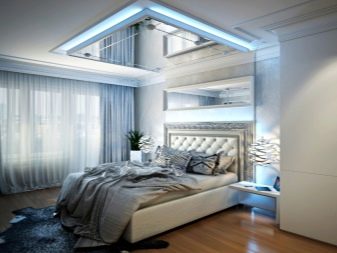
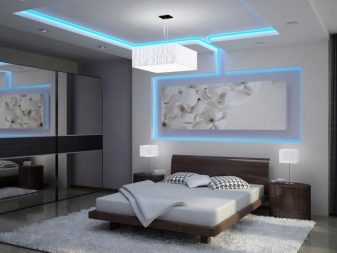
Along with the traditional matt plaster, on the ceiling in the neoclassical style, suspended structures are also finding worthy use... At the same time, the surfaces can be either completely flat or multi-stage, revealing great opportunities for the design of unusual lighting.
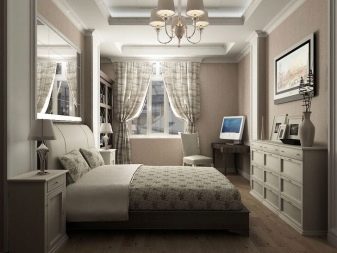

Ceiling design for Scandinavian style or country directions are often represented by a combination of drywall and stretch film. This adds sophistication. The result is sure to be to your taste, as there are many variations to choose from.

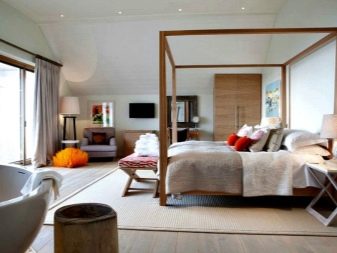
Reflective surfaces: mirrors, composite materials transform the perception of space. The combination of mirrored planes with gypsum board and lighting transforms the room, and it does not look so small.
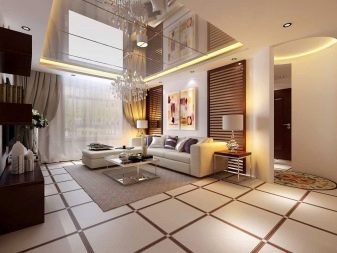
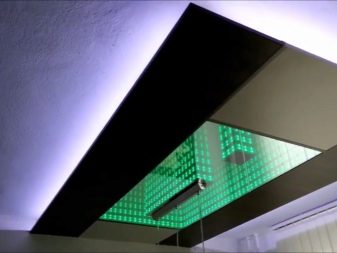
The plasterboard ceiling patterns in several levels represent whole architectural compositions in the style of futurism or postmodernism. If the room has low ceilings and it is impossible to install a 2-level structure, but I would like to find a beautiful patterned ceiling from gypsum board, then you can cut out the desired figure from the plasterboard sheet and simply glue it to the suspended ceiling.
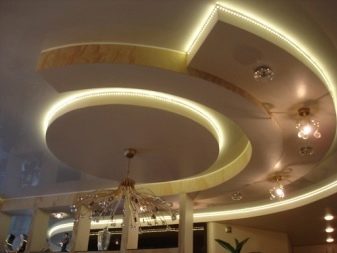
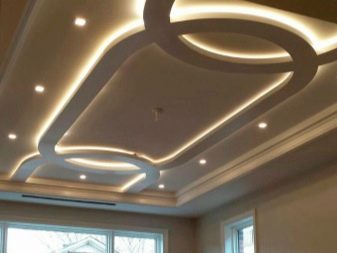
Choice of lighting and illumination
In addition to the usual chandelier and directional light sources (spots), there are a number of other methods that should be applied. There are several types of backlighting.
- LED backlight. It is excellent in that it can be guided and bent as you please. Through it, the same soaring ceiling is formed. For this, the diode strip is placed in a specially created cornice. You cannot see the light source, and it seems that the ceiling itself is glowing throughout the entire area. In fact, you are only observing a narrow band of light.
Another indisputable advantage of LED backlighting is the ability to change the color and saturation of the light stream using the remote control.
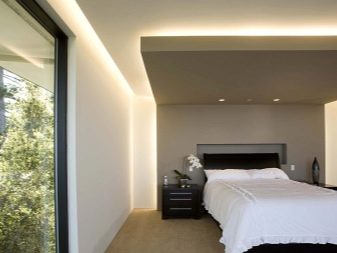
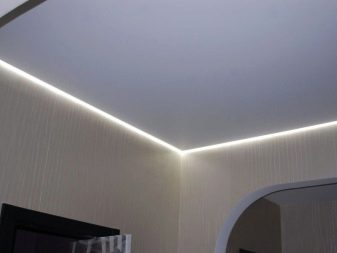
- Backlight hidden behind the stretch canvas, is found quite often in combined ceilings. It looks very attractive. However, it must be borne in mind that lamps have a feature to burn out. This means that it is necessary to envisage the feasibility of their easy and quick replacement.
Now let's talk about common lighting schemes.
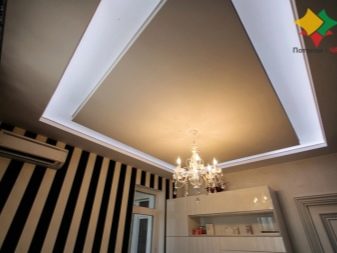
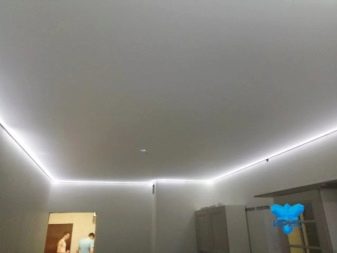
With chandelier
You will get a strong main light source. The chandelier is able to serve more powerful lamps or those that are prohibited for installation in a suspended ceiling. Spots are practiced as auxiliary lighting to form soft semi-darkness.
There are several options for the location of the chandelier.
- Chandelier in the center of the ceiling. Further composition is being built in relation to it. It can be symmetrical or asymmetrical, but the chandelier will invariably be its starting point.
- Two chandeliers are suitable for large rooms. Sometimes chandeliers on a long suspension replace the sconces close to the bed.
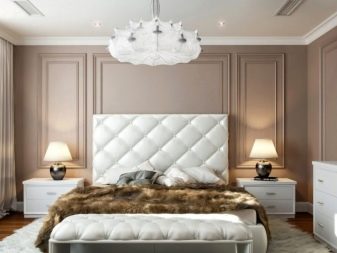
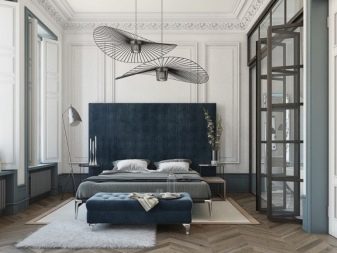
No chandelier
In this case, it will be necessary to add the number of spots in order to have the required 200 Lx, indicated by the sanitary standards.
Let's consider several options.
- Sources of directional light along the contour of the room. In the corners, in the form of geometric shapes, and so on. All lighting is concentrated along the contour of the ceiling.
- In the center. It can be a flat strip that includes one or more rows of fixtures. Or a winding "snake". The only leitmotif is to light the center of the room.
- In the corner. In small bedrooms, it is sometimes sufficient to place directional lights in one corner and spread the lighting in different directions.
- Matrix. By constructing an ornament from light sources (small diamonds, circles, etc.), you can make an elegant filling of niches in a multi-stage design.
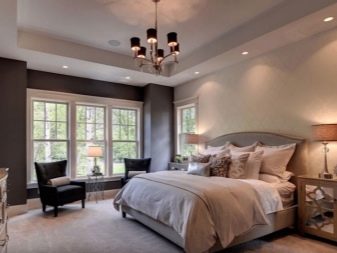
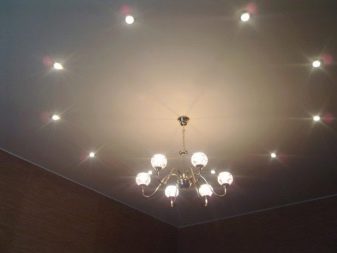
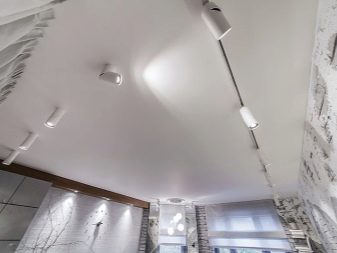
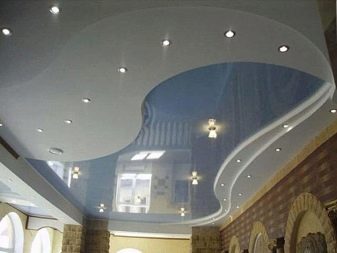
You will learn how to make a plasterboard ceiling in the following video.








